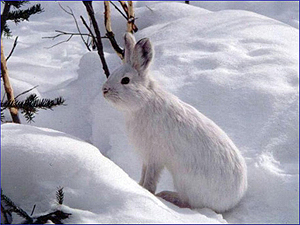White creatures changing with the season
White creatures changing with the season
Submitted by Ned Rozell
Phone: 907-474-7468
04/22/09

This morning, through the west window, I noticed a flash of white on white. I looked up from breakfast to see a short-tailed weasel popping from a hole in the snowpack. He was sleek, streamlined and snow-white, except for where his tail looked like he dipped it in black paint.
Then, when I skied to work, I saw a leggy snowshoe hare bound away, and then pause nervously. The sightings inspired me to call a neighbor that could tell me more about the animals’ white coats, the ones that won’t be white for much longer.
My neighbor, who may be hosting the weasel at this moment (their home range can be as expansive as 40 acres), is Dave Klein. Klein is curious about Alaska animals great and small, and has been since before he first drove up the Alaska Highway in the 1940s.
Klein, a professor emeritus of wildlife management at the University of Alaska Fairbanks, said that both weasels and hares undergo a molt that changes them from winter white to summer brown. That means they will soon replace all their white fur with brown fur, presumably to remain camouflaged for the change of seasons.
Triggering this color change is daylight, "but over long periods of time, (the fur-color change) is related to changes in timing of the melting of snow," Klein said.
For example, if warmer spring temperatures start to melt snow earlier, hares and weasels would be able to adapt and remain inconspicuous. According to Klein, that adaptation could take several generations, though.
Early adapters to a changing climate would pass on their genes. Late adapters might become lunch for great horned owls. Or, in the case of weasels, they might get no lunch at all.
Klein also offered up a few observations of animals that change fur color with the season. Arctic hares (larger than snowshoe hares and not confined to forests, often living on open tundra) in the high arctic of Canada and in Greenland stay white all year round. Replacing white fur with brown during the brief summer might be too costly energy-wise for those far-north hares.
"You can spot them from miles away in summer," Klein said.
Arctic foxes also show some fur-color variation, depending on where they live. On the Aleutians and the Pribilof Islands, most arctic foxes don’t turn white, instead they morph to a "blue" phase.
As you move farther north, arctic foxes have differing degrees of whiteness in winter. For example, while only a few foxes turn white on the Pribilof Islands, most of them living on St. Lawrence Island turn the color of snow. Arctic foxes on the North Slope always change to white, which Klein thinks might be important so "they can sneak up on polar bears on the adjacent sea ice and grab a snack," from a seal kill.
Brown lemmings, abundant in places like Barrow, don’t change the shade of their fur. Collared lemmings’ fur does change, perhaps because they leave the subnivean world under the snow more often than brown lemmings. The whiteness of collared lemmings gives them a chance to remain undetected by other hungry creatures wearing similar winter camo., like snowy owls and arctic foxes.
Those of you who read last week’s column may have expected more on Alva Wisdom of Seward and the 1964 earthquake. I was planning on writing up Luke Reid’s account of that evening in Seward, but Reid requested we keep that story between himself and Wisdom’s family. Al Wisdom died in Seward when a tsunami wave engulfed him on the evening of March 27, 1964, as he helped clear the only road out of town.
This column is provided as a public service by the Geophysical Institute, University of Alaska Fairbanks, in cooperation with the UAF research community. Ned Rozell is a science writer at the institute.


